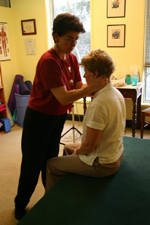|
|
|||||||||

What is the Feldenkrais Method?
Feldenkrais is a way of learning to move more easily. It does this by helping
people become more conscious about their movement and posture, enabling them to
move more efficiently.
Feldenkrais uses a gentle and subtle approach designed to avoid pain and
discomfort.
The Feldenkrais Method assists people:
• avoid overuse and general wear and tear on parts of the body - neck,
shoulder, arms, lower back, hips, knees and feet etc.
• recognise and then change stress-related patterns that affect posture and
movement.
• improve daily activities, e.g. sitting, walking, bending, lifting and
carrying
Conditions which can benefit from Feldenkrais?
| • shoulder and neck problems • overuse injury • muscle stiffness • chronic pain • stress-related physical problems • lower back pain • other muscular skeletal conditions. |
Physical pain, injury, illness and emotional stresses often result in patterns
of muscular tension in the body. These tensions lead to habits of posture and
movement which detract from a person's wellbeing.
More info
The Brains Way of Healing by Norman Doidge
Felden-what?
An Overview of the Feldenkrais Method
www.feldenkrais.org.au
|
See pix of a Feldenkrais
session |
Feldenkrais practitioners provide classes, individual appointments and workshops.
Classes in Awareness Through Movement - contact
In Feldenkrais classes the practitioner guides the participants through a series of movements. Participants learn about the sequences involved in movement and observe the subtle changes which occur in their bodies with each variation in movement.
This learning promotes a more conscious approach to movement amongst participants, and is designed to improve flexibility, coordination, balance and posture.
Individual appointments-Functional Integration -
contact
Some people benefit from individual appointments which address their
particular physical problem.
During the session the person lies or sits comfortably clothed on a low, padded table. The practitioner uses gentle touch to guide the person through movements that best suit their individual muscular and skeletal alignment. This will help the person develop new ways of moving and reduce pain and tension caused by their condition.
Workshops - contact
Workshops may also be arranged to focus on issues relevent to working environments.e.g. neck and shoulder problems; issues related to sitting etc.
